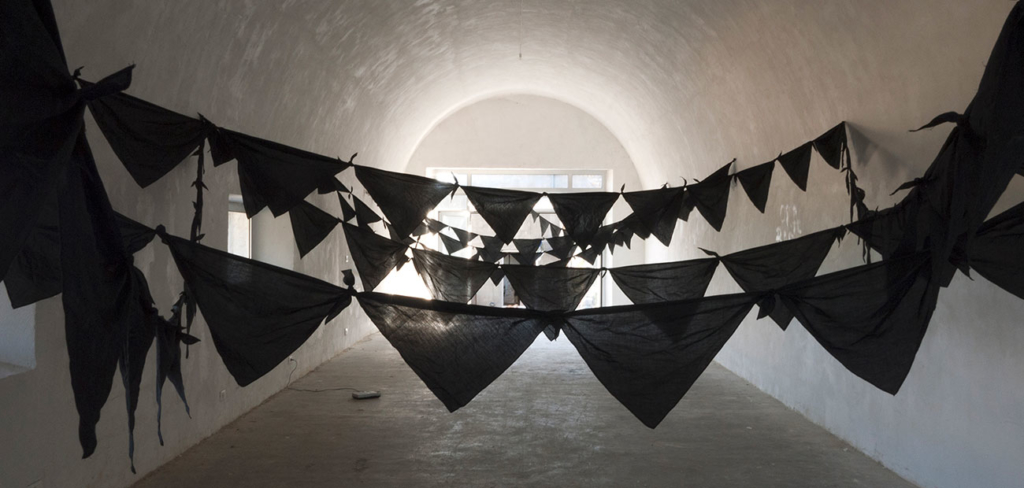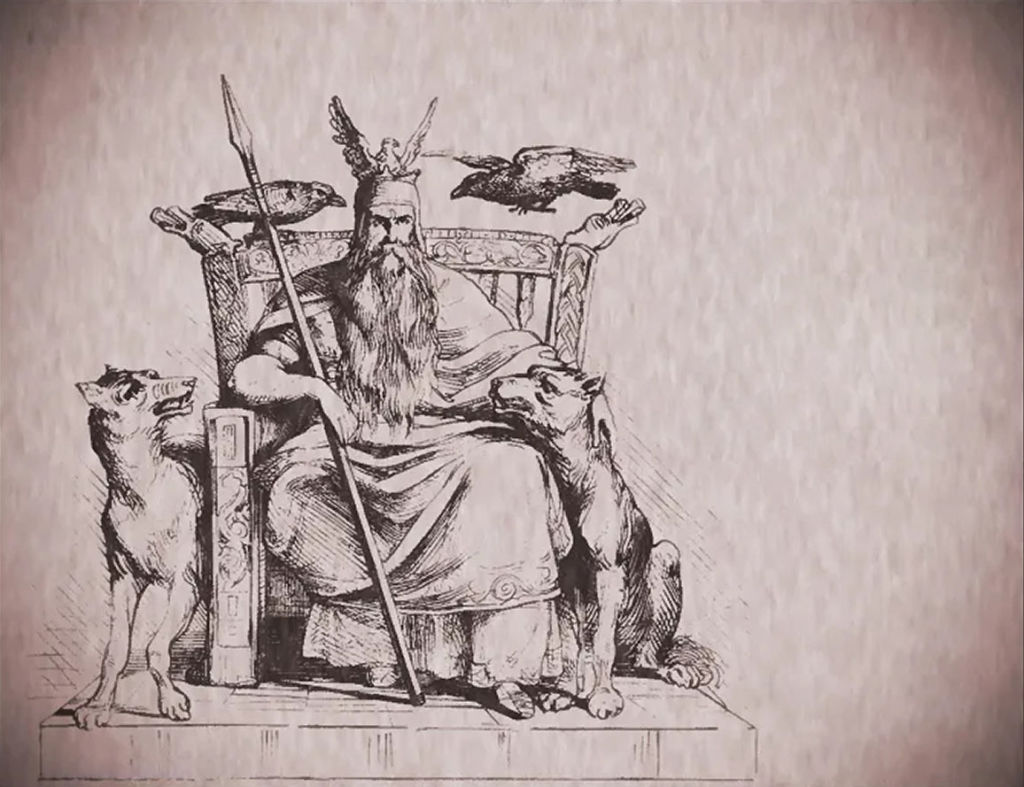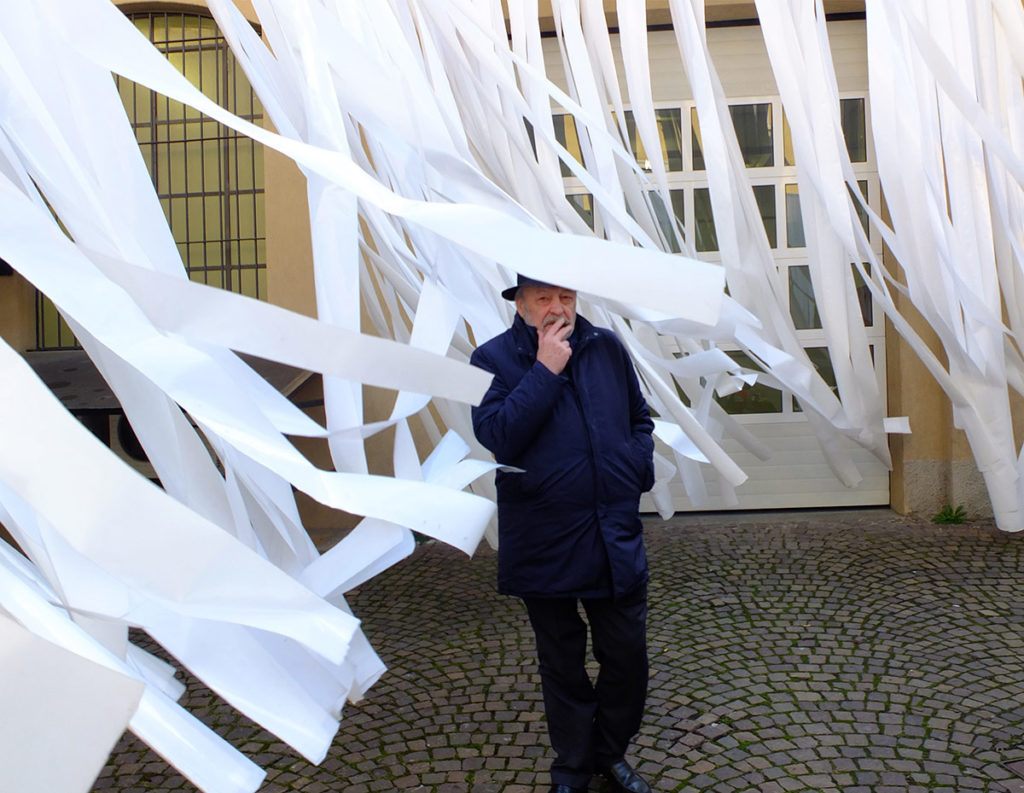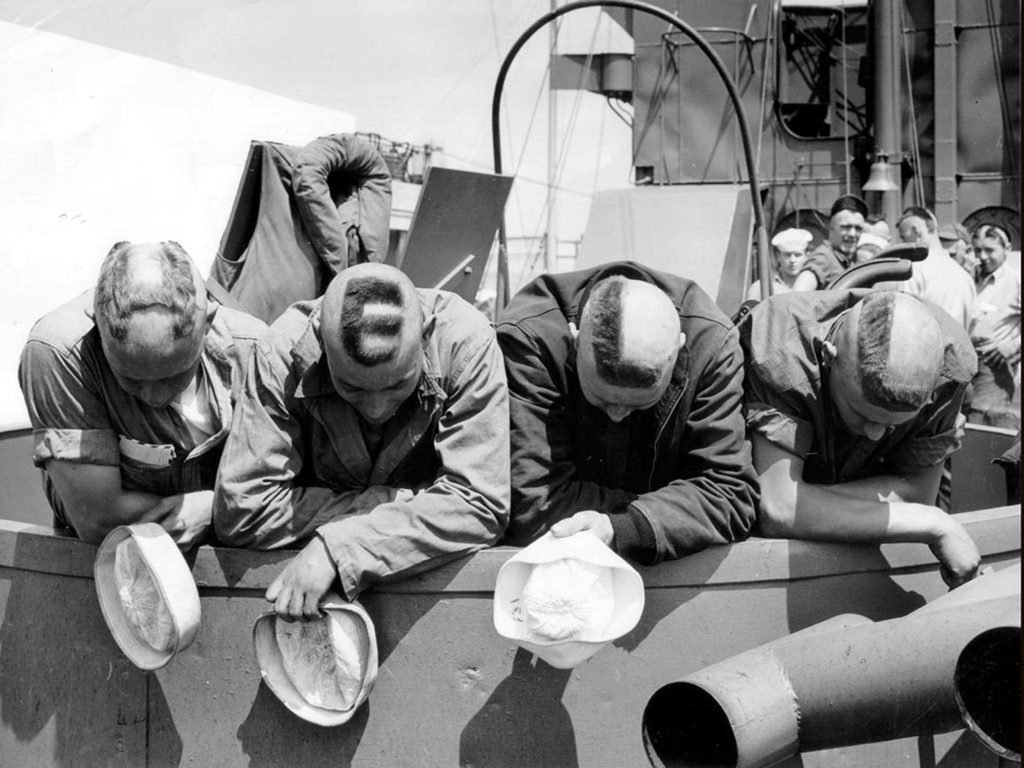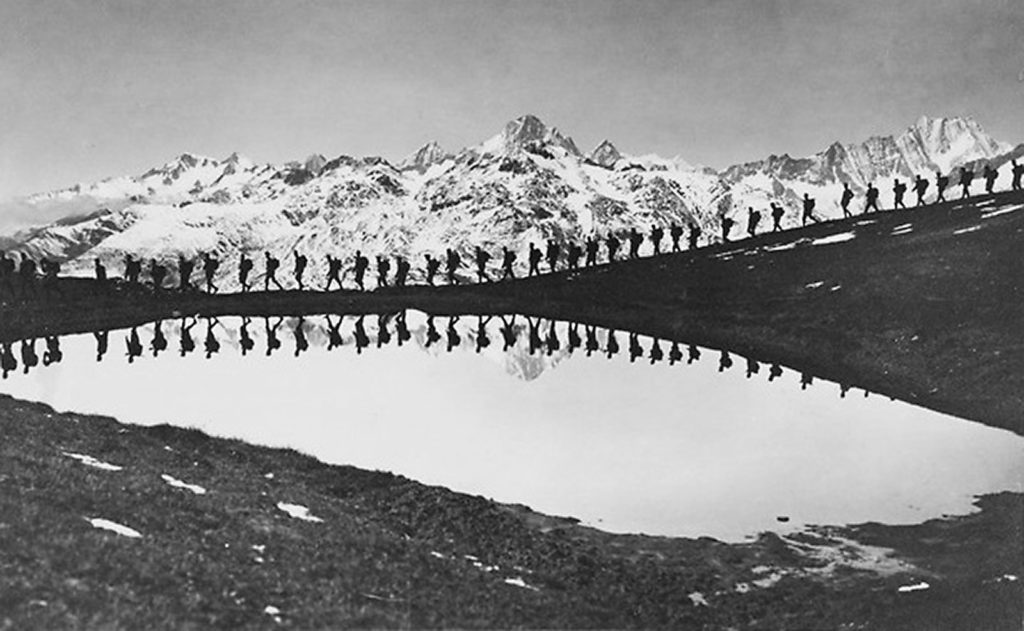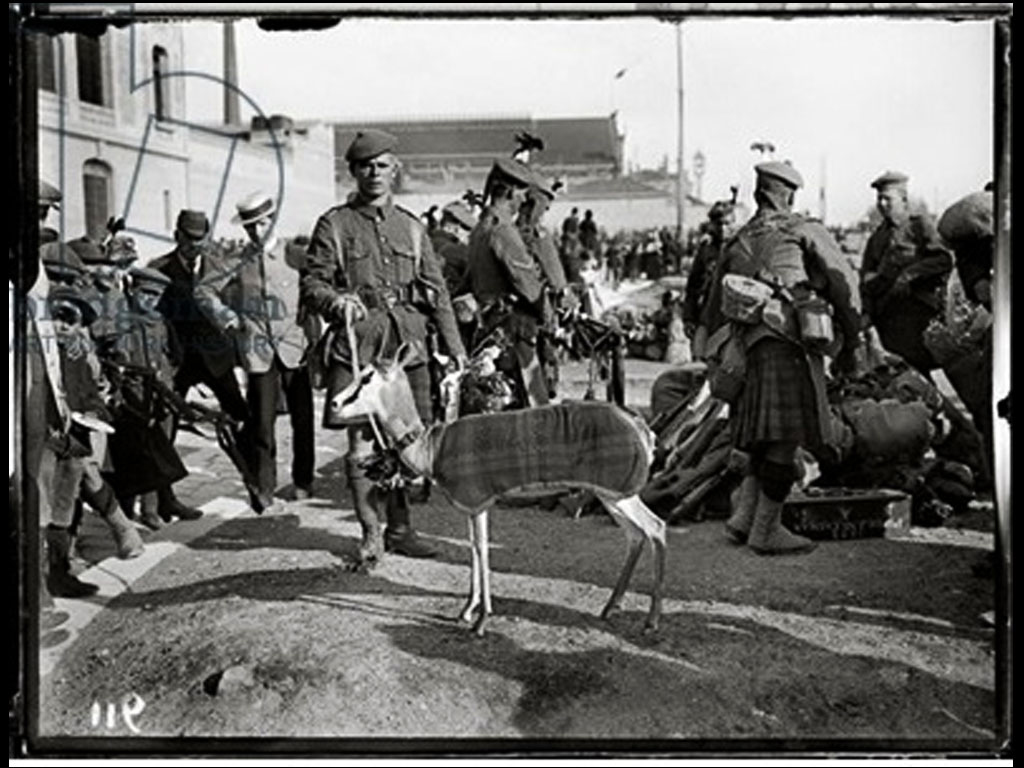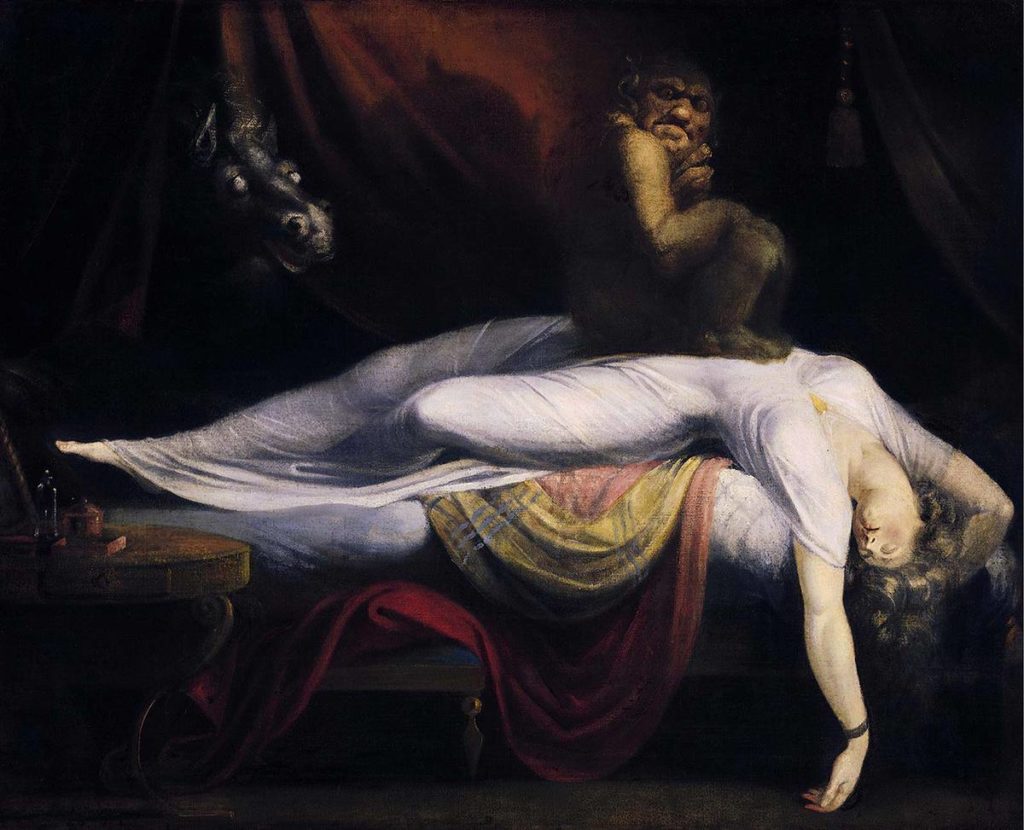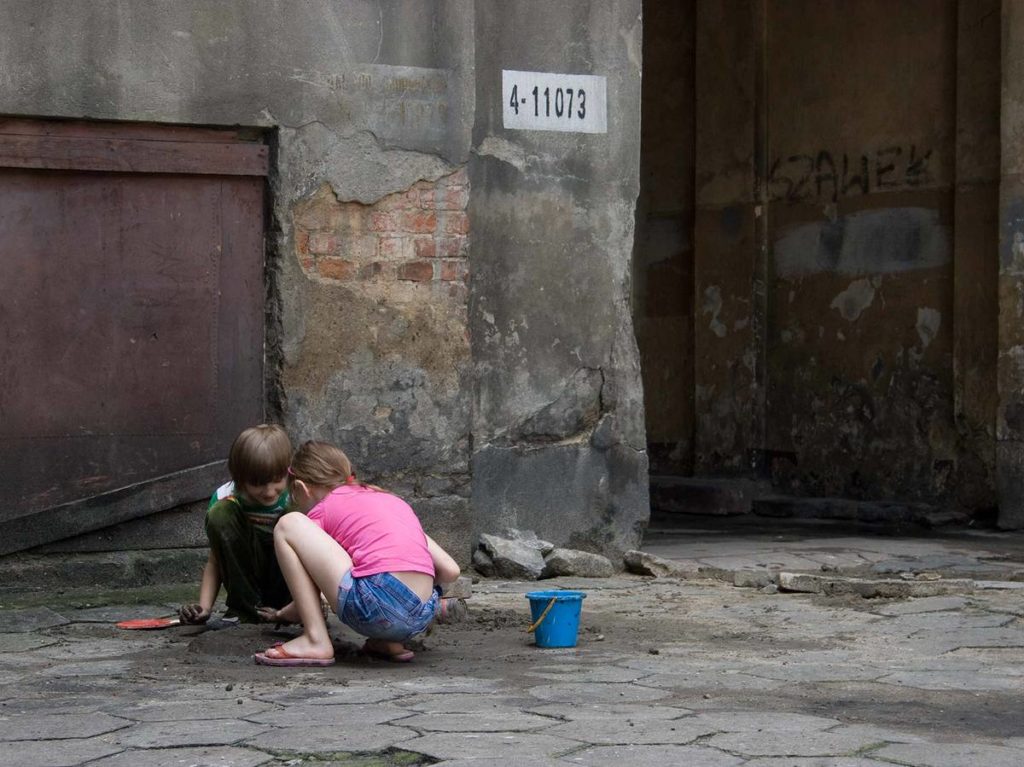Jean-Baptiste Ganne’s body of work harbors clear political messages all while spurning ideologies. Graffiti spill straight from the city streets onto the walls of exhibition galleries without losing their rebellious charge. A Roma woman’s headscarf twirling through space, Gypsy music brightly invading a castle cellar, and handmade shield-books are fitting responses to the discriminations and attacks from a world that is bent on getting older.
Jacques Rancière, Malaise dans l’esthétique (Galilée, Paris, 2004), p. 65.
Patrick Saytour, « Pourquoi les entretiens ? » dans VH 101, n°5, printemps 1971, p. 105.
Jean-Baptiste Ganne, Le Capital Illustré (Galerie Françoise Vigna, Nice, et Éditions Incertain Sens, Rennes, 2000). Il a été également publié en langue allemande : Das Illustrierte Kapital (Fotohof edition, Salzbourg, 2003).
Guy Debord, La Société du spectacle (Buchet/Chastel, Paris, 1967), p. 24.
Le messianisme de Barnett Newman qui a souvent été évoqué par ceux qui se sont penchés sur son œuvre n’a nullement supplanté son intérêt pour les thèses anarchistes, notamment celles de Pierre Kropotkine dont il a préfacé l’ouvrage Les Mémoires d’un révolutionnaire.
L’installation El ingenioso hidalgo don Quijote de la Mancha a été présentée à plusieurs reprises. Une première fois à Amsterdam en 2005, puis plusieurs fois dans différentes villes d’Europe ou du Moyen-Orient.
Le personnage de Quichotte n’a pas cessé d’intéresser les théoriciens, les écrivains, les musiciens et aussi les artistes. Parmi ces derniers, nous pouvons citer Goya, Hogarth, Daumier, Picasso, Dali ou Germaine Richier.
Georg Lukács, La Théorie du roman [1920] (Gonthier, Paris,1963), p. 99-100.
Michel Foucault, Les mots et les choses, Une archéologie des sciences humaines (Gallimard, Paris, 1966), p. 62.
Ibid, p. 60.
Ibid.
Haim Steinbach, on vend du vent (1988), peinture latex noire mate ou lettres en vinyle noir appliquées sur le mur, Collection capc Musée d’art contemporain, Bordeaux, don de l’artiste en 1990.
Entretien entre Jean-Baptiste Ganne et Maurice Fréchuret dans Jean-Baptiste Ganne, Gélem Gélem (Musée national Pablo Picasso, Vallauris, et Éditions DEL’ART, Nice, 2014), p. 16
Ibid, p. 16
Šaban Bajramović, né en Serbie en 1936 (alors Royaume de Yougoslaie) et mort en 2008, est une figure centrale de la culture rom. Il fut emprisonné durant cinq ans sur l’île de Goli Otok pour désertion et insoumission durant son service militaire. Ses chansons sont fréquemment utilisées dans les films d’Emir Kusturica.
Le peuple rom est un peuple sans écriture. Les translittérations de l’expression dans la langue et l’alphabet des pays d’accueil explique le nombre très important de vocables utilisés : Gyelem, Gyelem, Đelem, Đelem, Dželem, Dželem, Gelem, Gelem, Ђелем, Ђелем, Ѓелем, Ѓелем,Џелем, Џелем, ou encore Джелем, джелем.
The installation and electronic device have been made possible thanks to Vivien Roubaud technical skills. Kerwin Rolland used his own to produce the specific sound display<span class=”gmail-s1″>.</span>
Jean-Baptiste Ganne, Gélem Gélem, op.cit., p. 11.
Jean-Baptiste Ganne a consulté des ouvrages sur le sens de ces deux mots : « J’ai lu “Disóccupati !” (“Désoccupe-toi !”) au lieu de “Disoccupati !” (“Chômeurs !”). La différence entre les deux mots ne tient qu’à la position de l’accentuation lorsque vous prononcez l’un ou l’autre. Le verbe italien “Disoccuparsi” incarne la beauté de cette magnifique posture. »
Guy Debord, op. cit., p. 31.
In his book Aesthetics and its Discontents, Jacques Rancière, discussing the role of the artist-activist, ventured to define their practice. Art, from this perspective, is that which “sets out to build awareness of the mechanisms of domination to turn the spectator into a conscious agent of world transformation1.” Though this statement shows a clearly defined objective and a well-formulated idea, the “ways of doing,” to stay in the author’s lexicon, remain unspecified. As such, innumerable artistic practices might find elements of legitimization through this definition. Works that respond to the imperatives of Proletkoult, whose ideological content was established by Andrei Jdanov, as well as proponents of Brechtian distancing and the didactic scope they imply; from the great canvas-manifestos of André Fougeron or Renate Guttuso to the equally important ones by some members of Supports/Surfaces, art departs from the realm of pure esthetics to open itself to the sociopolitical reality of the world and, consequently, contribute to transforming it. The explicitly propagandist iconography of socialist realism, which vowed to work toward the political edification of the masses, effectively takes an opposite stance to the tenants of art for art’s sake, whose sole concern is to renew the forms of visual artistic language. It was, paradoxically, in the name of a similar auto-referentiality that the painters of Supports/Surfaces loudly proclaimed their allegiance to revolutionary principles, or at least to ideas they considered as such. Deconstructing and questioning painting and its categorical elements allowed them, indeed, to display their materialist options and legitimize them, just as Patrick Saytour, one of the movement’s painters, said: “We’re speaking through painting and not about painting, and this language is operational, that is,
political2.”
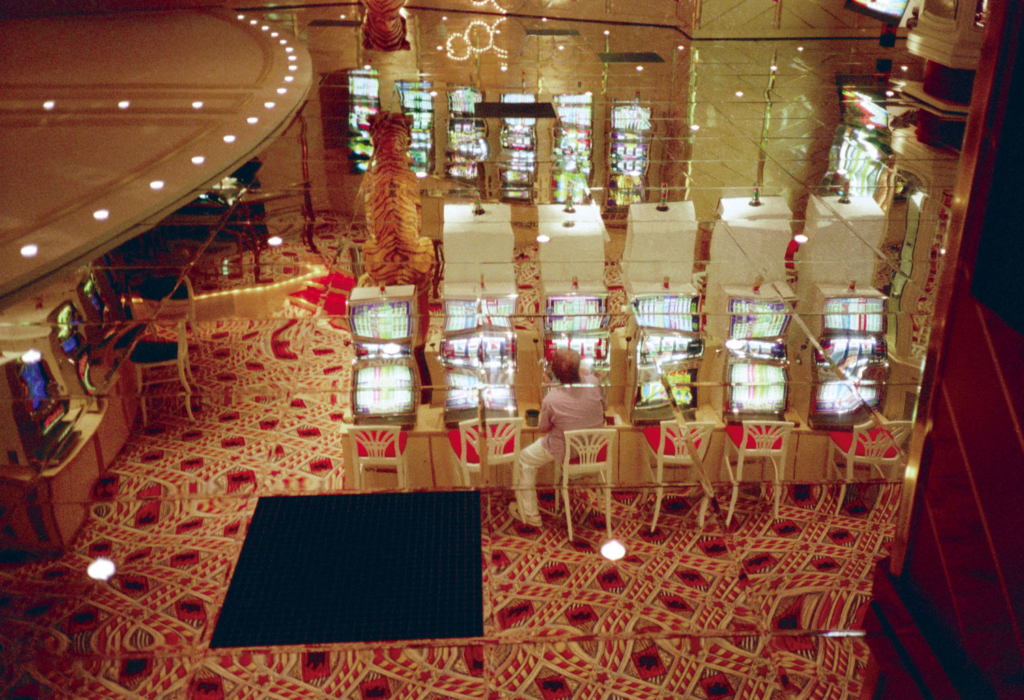
Jean-Baptiste Ganne, The Capital illustrated (Hoarding – I, III, 3, A), taken from the corpus (1998-2003), color photography.
Quite Unsuspectingly
Between these two ways of thinking and practicing artistic creation, there is still room for art that does not resort to heavy-handed demonstrations of ideology or biases dictated by peremptory manifestos. Such is the case of Pablo Picasso’s art, which neither ignored politico-historical facts nor did it seek to exhibit them. The pots, plates and chandeliers he painted in still life during World War II bear witness to the violence of the time, speaking it all while discretely denouncing it. The same goes for André Masson, Joan Miró, and Jean Fautrier who, amongst other artists of that generation, created artworks that were, for the most part, open to historical flux without necessarily being subjugated to it.
Other artists in our day have adopted a similar attitude. Their works also engage with history, denouncing the torment it inflicts on humans and the losses they must suffer. These works, opting for a path we might qualify as political, jointly maintain, pursue and develop their intrinsic potential and fully assert their status as art objects. And so works by Adrian Paci, Alicia Framis, Kader Attia, Bathélémy Toguo or Zineb Sedira contribute to a relationship between art and politics that is not conflictual, where one most dominate the other, rather the contrary: the message requires the emergence of the most appropriate form, which in turns amplifies the intended statement.
Jean-Baptiste Ganne’s works are, in this sense, some of the most relevant today. All the more because the artist takes on the most imposing, not to say cumbersome, subjects from an ideological point of view. Since the very start of his research, Jean-Baptiste Ganne has undertaken the vast project of tackling Karl Marx’ seminal work, Capital, and illustrating its main themes. One element is undoubtedly behind this venture: Étienne Balibar’s classes at Nanterre, which the artist attended from 1991-1992. The collection Reading Capital, with contributions from multiple authors including Étienne Balibar and Louis Althusser, Jacques Rancière and many others, is followed by Le Capital illustré [Capital Illustrated], which Jean-Baptiste Ganne develops from 1998-2003 using photographs taken in the most unexpected places and circumstances: a racetrack, a fashion show, a car race, a high-society cocktail party or a working-class streetscape in Belleville. Each snapshot is presented alongside a chapter or passage from Marx’s work and acts as a kind of epigraph. Marx’s critique of the division of labor in linen manufacturing, or more generally the textile industry—a topic the author broaches in the section on producing relative surplus value and the chapter on automation and big industry—finds itself illustrated when paired with a photo from a fashion show, characterized by the relevance of choice and ironic distance. Similarly, the chapter on the struggle for the normal working day is paired with an entertaining scene of people enjoying the swimming pool, and the chapter on wealth hoarding is accompanied by a casino full of slot machines viewed from above. The photo-essay today includes 48 images, presented in its entirety on a vast 14-meter-long panel or consulted in book form3. In both configurations, the work proves Guy Debord right for saying, nearly fifty years ago, with uncanny clairvoyance: “The spectacle is capital accumulated to the point where that becomes image4.”
The class struggle espoused by Marx and Marxists, as well as by others motivated by anarchist and anti-authoritarian thinking, the very struggle on which worker and the general population’s emancipation is founded, also finds its place in Jean-Baptiste Ganne’s work. Like in Le Capital illustré, the use of metaphorical figures prevails over explicit declarations and peremptory or affirmative notification. The installation Who’s Afraid? (Tapis de Lutte) (2011), which the artist created for the acta est fabula exhibition in Vidéochroniques art center in Marseille, provides an excellent overview. The exhibition floor is entirely covered by a carpet that recreates the pattern and colors found in martial arts training halls: blue, red and yellow spread along the entire surface in concentric circles. As a fan of ancient Greco-Roman wrestling, Jean-Baptiste Ganne transposes revolutionary theory to this particular field, which the Olympic spirit has vowed to protect from all political intrusion. Class struggle and athletic struggle share the same space here, where brilliant colors bear a good omen for the one and the other.
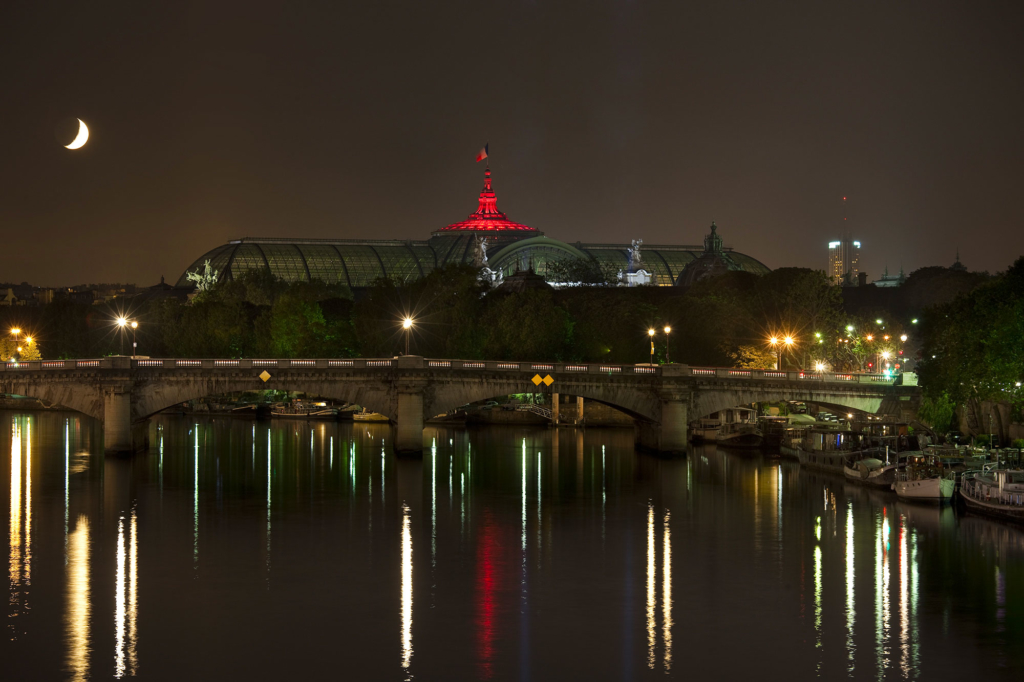
Jean-Baptiste Ganne, El ingenioso hidalgo don Quijote de la Mancha (2005). Integral lecture in Morse code of Cervantès Quixote, 23.04.2009 – 04.06.2009, Paris Grand Palais.
Primary Colors
Yellow, red and blue are the primary colors in art and many artists have chosen to use them, sometimes exclusively, for their visual quality and intensity. Piet Mondrian turned them into his neo-plasticist credo and vowed only to use them in conjunction with white and black, the two fundamental non-colors. With these colors alone, laid flat and outlined by vertical and horizontal lines, the artist established an entire oeuvre and shaped his vision of the call for a new society.
Around the same time, Alexander Rodtchenko created three monochrome paintings he entitled Pure Red Color, Pure Blue Color, Pure Yellow Color. Presented in 1921 during the 5X5 = 25 exhibition in Moscow, the triptych was considered a kind of unbeatable sum that, for some, signified the end of art and, unanimously, the beginning of a new world and way of life. For his part, American painter and sculptor Barnett Newman attempted some thirty years later to bring new vitality to these three colors. With his series of four imposing paintings, Who’s Afraid of Red, Yellow and Blue (1966-1970), the artist attempts to rehabilitate these three colors and ask why they elicit such a fearful disturbance when presented alone, for their own sake. He too associates them with a project, but unlike Rodtchenko, his does not purport to end artistic practice, rather announces a new beginning, a new era in line with his political convictions, which were heavily influenced by anarchist
theories5.
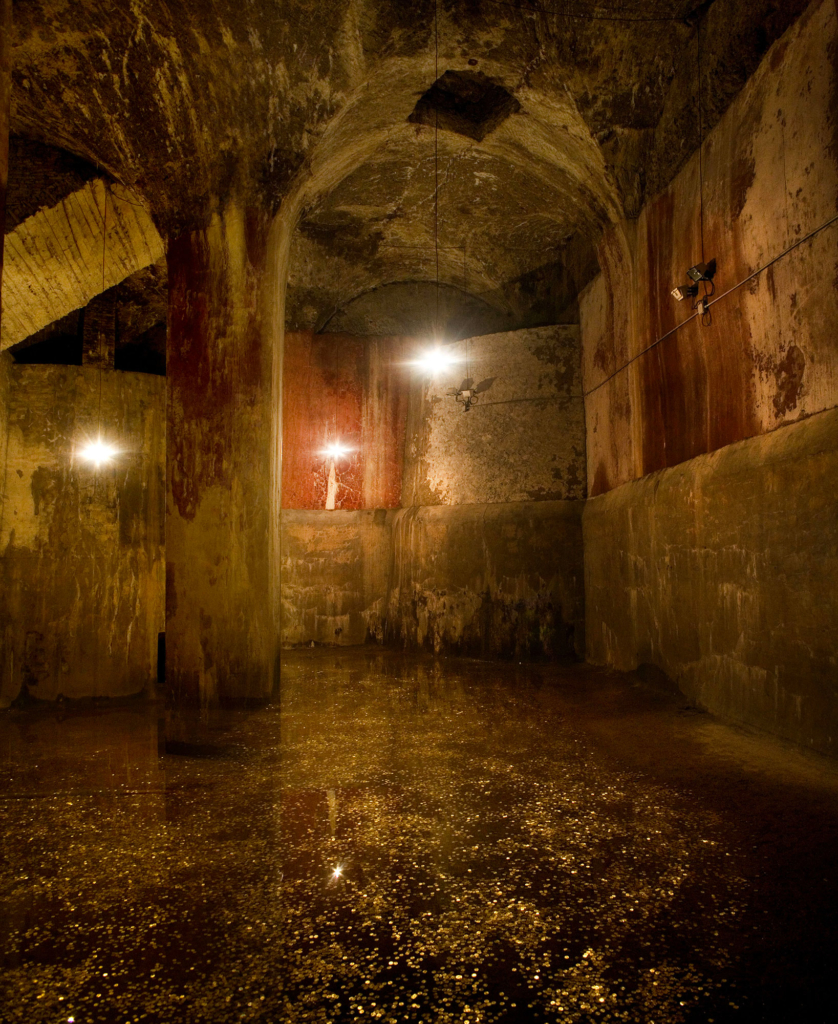
Jean-Baptiste Ganne, Senza Titolo (All that Glitters is Gold) Installation for Luce di Pietra exhibition, 100 000 10-cents italian coins, Villa Médicis, Rome, 2007.
An Ingenious Hidalgo
The title of Jean-Baptiste Ganne’s work, Who’s Afraid? is a truncated but direct quote from Newman. Ganne often quotes directly from his sources. He did so in El ingenioso hidalgo don Quijote de la Mancha, a piece created and presented for the first time in 2005 in Amsterdam—exactly 400 years after the novel by Miguel de Cervantès was published. This light installation was activated day and night for nearly forty days from the artist’s studio. A red lamp, visible from the outside, flashed the entire two volumes of the book in Morse code. The short and long pulses were a one-to-one rendition of the several dozen chapters6. Jean-Baptiste Ganne’s decision to use one of the most famous books in the history of literature is no coincidence. The innovative style of writing, the story of an adventurer, and above all, the book’s political impact—elements which all made it an international success—were not lost on Ganne, who was receptive to its fantastic and disheveled storyline yet extreme lucidity on the habits and customs of its contemporaries. Most likely written while the author was detained in a civilian prison in Seville, the character Don Quixote manages to critique everything around him, and his fight, vain though it may seem, ends in an absolute questioning of the world order. People across eras and disciplines have written about the book and tried to analyze its protagonist’s personality, and all have seen Quixote as an extraordinary being, a man with an exceptional destiny7. In The Theory of the Novel, Georg Lukács sees him as a warrior figure fighting on behalf of an “interiority against the prosaic vulgarity of outward life8,” and in The Order of Things, Michel Foucault, who analyzes the text in its entirety, concludes: “Don Quixote is the first modern work of literature, because in it we see the cruel reason of identities and differences make endless sport of signs and similitudes9.”The author discerns the character’s profile with utmost acuity, imaging and giving him shape. He ultimately assimilates him to a system of signs, because, as he continues: “His whole being is nothing but language, text, printed pages, stories that have already been written down. He is made up of interwoven words; he is writing itself, wandering through the world among the resemblances of things10.” By transcribing Cervantes’s novel into Morse code and having it broadcasted into the city, Jean-Baptiste Ganne falls well in line with Foucault’s ideas. He brings these fable-signs to life and through this luminous flux, reproduces the troubling image of Quixote, that “long, thin graphism, a letter that has just escaped from the open pages of a book11.”
Windmills harness a force that belongs to none, it is because the latter has no commercial value. Haim Steinbach’s catchphrase, On vend du vent [they’re selling hot air] only works as a metaphor for the art system because artworks and their exhibition have become commercial goods12. Jean-Baptiste Ganne raised this critique again while in residency at Villa Medici in Rome when he attempted to coat the bottom of the Villa’s Roman fountain with a quantity of coins equivalent to the sum allotted to producing the exhibition. Several tens of thousands of coins were therefore dumped onto the fountain floor. Low lighting emphasized the installation’s strangeness. The work, Senza Titolo (All that Glitters is Gold), created in 2007 for the exhibition Luce di Pietra (Rome), shows us that despite the title, not everything that glitters is gold, but that as they noisily clank about, coins dispersed this way cannot hide their true function, their value as money. To throw a coin into a fountain is a symbolic gesture, and dumping shovelfuls of coins, as was the case here, is an ironic reminder of the brutal reality of our world and our dominant economic system. Jean-Baptiste Ganne strips a work of art bare, removing the aura we usually try to wrap around it, forcing it above all to reveal its commercial value. If before him, Andy Warhol filled his canvasses with reproductions of dollar bills and dollar signs to signify the equivalence of all things represented (flowers, accidents, electric chairs…), if in 1969, Cildo Meireles exhibited a stack of one hundred Brazilian cruzeiro banknotes held together by a rubber band (Árvore do Dinheiro) to underline the difference between the nominal value of banknotes and the exponential value of the artwork in question, Jean-Baptiste Ganne establishes the exact value, to the last cent, of the exhibited work, thereby lending new meaning to Frank Stella’s famous saying, “what you see is what you see.”
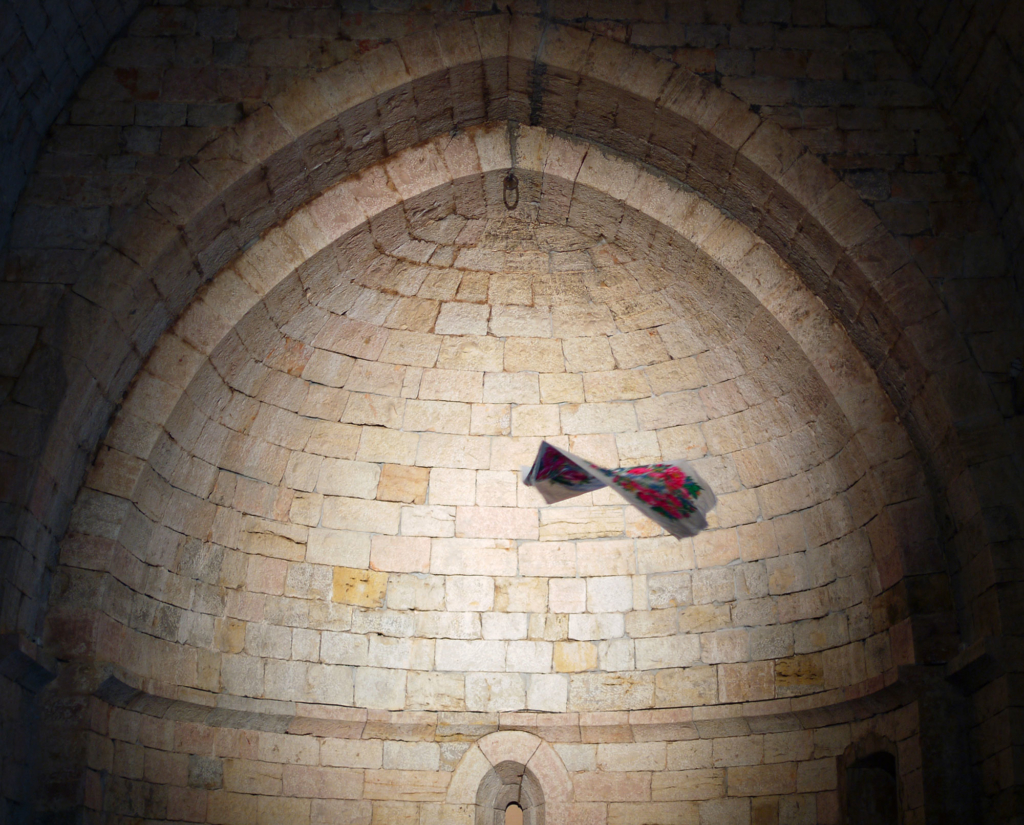
Jean-Baptiste Ganne, Gélém, Gélém, 2013 Light and sound installation (detail), Musée Pablo Picasso, Vallauris.
Pour voir la vidéo, cliquer sur l’image.
The writing on the wall
How we use our gaze is a preoccupation for any visual artist; and it is of course requisite whenever Jean-Baptiste Ganne intervenes in a space. A keen observer of urban environments who is constantly scrutinizing the traces left on walls—marks conveying the anger of those who approached them, the stigmata of violence done to disfigure them, or even the affectionate words a well-meaning hand left there to address an object of affection—Ganne provides his own take on what there is to read, inviting us to decipher the signs he enjoyed reproducing on his studio walls, or in the exhibition space, or on the front marquee of a public building. But this decoding is short lived, because the artist only gives us the essential: never any long tirades, only a few words caught hastily and re-transcribed as they are, come to warn us about the world’s injuriousness and the salutary reactions of rejection it provokes. Picked up in Nice, Marseille, Brussels, Paris, Freiburg, just about anywhere, these banal or precious writings find themselves transported elsewhere, recomposed down to the last detail: “Ici des hommes on travaillé très dur”; “Squat this world”; “birra gratis per I lavoratori”; “No nos representan”; or the generous “Omnia sunt communia.” These words, phrases or slogans are read in passing, quickly, unsuspecting, but revive the history of wall drawings and of wall art in general. Jean-Baptiste Ganne reiterates propositions made by artists like Barbara Kruger, Jenny Holzer, Haim Steinbach, Robert Barry or Peter Downsbrough, however unlike them, what he shows, what he re-transcribes onto the gallery walls, are things that have come from walls themselves. His writings on the wall, sometimes written on the surface, sometimes clearly carved into the wall itself, are not the scholarly and somewhat elliptical sentences issued from the artist’s imagination, but come from the street in all its plain, frank language. In this sense, one could say that Jean-Baptiste Ganne’s art is trivial art, if you take the word for its original meaning, as in the crossroads where three paths intersect. And yet, the artist’s work could not be mistaken for what we refer to as Street Art today. Although the street, what happens and is written there, are a real source of inspiration for him, it is only in light of how he might twist and reappropriate these extractions, which, brought to a new space, see their original message greatly enhanced.
The street and what happens there, we were saying. We live in a historical period that is singular for its high number of conflicts between protesters and the forces of order. Algeria, Hong Kong, Lebanon, France, Italy… and many other places see rebel confrontations on the rise and often escalating into riots. On the police side, weapons are increasingly sophisticated and effective. On the protester’s side there is less variety in the arsenal, which generally consists of the typical elements used in street clashes and their correlate, defense. In Italy, since 2010, protesters occupying universities have been making their own protective shields to ward off projectiles shot by the police. Handmade out of scraps of reinforced cardboard, Plexiglas and foam, cut down to size and chosen for providing efficient cover, these shields differ from the ones ordinarily used by the Black Blocks, and their German counterparts the “Schwarzer Block,” in that the outward facing side displays the title of a book and its author. With Plato’s The Republic, Karl Marx’s Kapital, Henry Miller’s Tropic of Cancer, Theodore Adorno’s Negative Dialectics or Gilles Deleuze and Félix Guattari’s A Thousand Plateaus, an entire library marches out to meet the established order and fend off its attacks. Jean-Baptiste Ganne, in an installation entitled Book Block (2018), reuses the idea of shield-books, positioning them upright, sometimes using a cobblestone to keep them standing straight. They are made exactly like the ones used in street protests and, like those, also display a title and author. Nathalie Quintane’s Les Années 10 rubs elbows with Gisèle Freund’s Photographie et Société. George Orwell’s 1984 stands across François Villon’s La Ballade des pendus and Samuel Beckett’s Endgame has a spot near Bertrand Russel’s In Praise of Idleness. Together they make for a very animated zone, with the outward-facing panels bearing this literary information brightly colored, and the inner sides revealing straps for attaching them to your arm. When it comes to shields, Jean-Baptiste Ganne has a preference for ones that speak of our collective heritage, as opposed to the armor, insignia, symbolic and heraldic figures of Medieval, Roman or Merovingian shields. He opts for the protection of world literature by authors who often also had to wage battle against institutions and the norms they impose.
Acting as both defensive weapons and the standard-bearers of great thinkers, these vivid shields contrast with the black scarf triangles tied together end-to-end in a garland that draws a protective pentagram in the exhibition space. These cloth swaths usually act as protection against the tear gas used by police in street conflicts. They also mask the face, thus providing anonymity for Black Blocks participants. The usual symbolic dimension of the pentagram and the talismanic values it commonly confers are accessory here, yielding to the anarchist spirit of an encircled A, revealed in the stellar intersections of the lines that compose it. Black Block Beauty (2016) is right there next to one of Ganne’s wall-drawings of equally political content. And so On dansera sur les ruines de vos belles vitrines We’ll dance on the ruins of your beautiful vitrines, painted in reserve on a wall in the space, keeps alive the memory of Situationnist slogans that once adorned the walls of Paris: “Consume more, you’ll live less,” or the even more incisive, “How can one think freely in the shadow of a chapel?”, as written at the entrance to the Sorbonne chapel in May 1968.

Jean-Baptiste Ganne, Tribute to Robert & George. Red wall painting, Run Run Run exhibition view, Villa Arson, Nice, 2016
The People of a Hundred Names
The street, where art, history and politics meet, was and remains an inexhaustible source of inspiration for Jean-Baptiste Ganne. However, aware of the reservations and limits he faces as an artist, he adds: “It is not about creating a political art of struggle, which would be an illusion in my opinion, but about choosing to use political elements in order to provide some representation for political gestures, groups or (in reference to the Roma) a community13.” He says he is fascinated by “this free people that make no territorial claims and have never waged a war.” For him, the Roma form “a figure of otherness in which artists often see themselves reflected by adopting them as a metaphor for their own position14.” For all these reasons, the artist has granted the Roma a choice place in his work. First by dedicating an installation entitled Rrom Dance Floor (Monumento per Šaban Bajramović) in 2008 to Šaban Bajramović, a Serbian-born member of the Roma community. A highly talented musician and performer, Bajramović greatly enriched the music of his people by creating nearly seven hundred original compositions. In the flooded basement of a medieval castle in Apricale, in the Merdanzo valley near Bordighera (Italy), five lamps hanging 1,5 meters above the ground turn on and off to the tempo of amplified music. Four hours of Roma music from various countries (Romania, Hungary, Serbia, Bosnia, Macedonia) make up a compilation representative of the music that Bajramović in large part helped to make known throughout the world. As the composer of Djelem, djelem, which has become the hymn of the Roma community, he stands for freedom and an unobstructed life15. Long imprisoned under the Tito regime, he transformed his reclusion into a “university of life” and, through a vast amount of reading, nourished his view of a world that seems intent on stigmatizing the way of life of his people.
As we said, the song Djelem, djelem is the official song of this nomadic people. When spelled slightly differently, it is also Gélém, Gélém, the title of an installation by Jean-Baptiste Ganne created in 2013 at the Musée National Picasso in Vallauris16. A lone headscarf, acquired previously from an elderly Roma woman encountered in the streets of Nice, dances in the space. It displays colorful floral patterns rendered even more vibrant by the lighting, which illuminates the scarf as it twists and turns17. A selection of Roma musical pieces completes the scene thanks to another sound device, trully fundamental in the installation because, as the artist explains, “this music contains the history of the Roma people, their ostracism, the attempts to subjugate them, their journeys and settlements, and also the genocide they suffered during World War II18.” Gélém, Gélém evokes pogroms and other persecutions—such as slashings and killings at the hand of the Black Legion—but it also evokes daily life, sharing resources, the solidarity and the joy of being together. “I walked, I walked” is how one might translate the title, an homage to this people and culture or, as the artist puts it, “an invisible monument” in their honor.
Invisibility is not absence. Though it is often the stuff of movies or magic shows, the notion also belongs to our daily world and, as such, to art. Proof of this is in the very choices made by Jean-Baptiste Ganne. “Do not add any more objects to the world” is what the artist vowed in response to the command Disoccupati, Disoccuparsi19! When forced by necessity to produce an object, to transform matter, his action is always carefully limited to the essential. It is the artist’s responsibility, he explains in the aforementioned interview. This responsibility, which Jean-Baptiste Ganne takes great pains to define as the motor behind his art, leads him to undertake an active, rather radical reading of the world and, paradoxically, to reject any and all ostentatious demonstration or heavy-handed production. All in the name of avoiding adding more to a world in which “not only is our relationship to merchandise visible, but it is all we see: the world we see belongs to it20.”
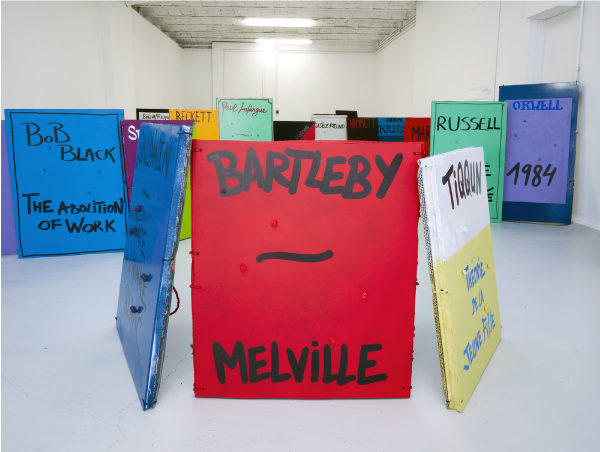
Jean-Baptiste Ganne, Book Block, mixed medias, 2018. In Praise of Idleness exhibition view, Territoires Partagés gallery, Marseille.
Translator : Maya Dalinsky
Editor: Vincent Simon
Cover: Jean-Baptiste Ganne, Black Block Beauty. Knotted scarves as pentacle, exhibition view, Triangoli neri su fondo bianco, Dolceaqua Arte Contemporanea, Italy, 2016
